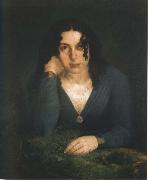 |
Lilly martin spencer -- Click Here
|
|
1822-1902
American painter of English birth. At the age of eight, she and her family emigrated to America, and after three years in New York they moved to Marietta, OH. In 1841 her father took her to Cincinnati, where she exhibited and received help from artists such as the animal painter James Henry Beard (1812-93). However, she refused the offer of the city's most important art patron, Nicholas Longworth, to assist in her art studies in Boston and Europe. Instead she stayed in Cincinnati and married an Englishman, Benjamin Spencer, by whom she had thirteen children, seven living to maturity. |
|
 |
Lilla Cabot Perry -- Click Here
|
|
American Impressionist Painter, 1848-1933
was an American artist who worked in the Impressionist style, rendering portraits and landscapes in the free form manner of her mentor, Claude Monet. Perry was an early advocate of the French Impressionist style and contributed to its reception in the United States. Perry's early work was shaped by her exposure to the Boston school of artists and her travels in Europe and Japan. She was also greatly influenced by Ralph Waldo Emerson's philosophies and her friendship with Camille Pissarro. Although it was not until the age of thirty-six that Perry received formal training, her work with artists of the Impressionist, Realist, Symbolist, and German Social Realist movements greatly affected the style of her oeuvre. Boston native Lilla Cabot Perry was born on January 13, 1848 to Dr. Samuel Cabot, a distinguished surgeon, and Hannah Lowell Jackson Cabot. What is known of her early life reveals a childhood that allowed her the freedom of exploring her interests and creativity. Perry studied literature, language, poetry, and music. There are a few references to Perry having informal sketching sessions with her friends however she had no formal training in the arts before 1884. As a child she additionally enjoyed reading books and playing sports outdoors. Because of her family's prominence in Boston society, |
|
 |
LIGOZZI, Jacopo -- Click Here
|
|
Italian painter, Florentine school (b. 1547, Verona, d. 1627, Firenze)
Italian painter, draughtsman, miniaturist and printmaker. He was one of the most productive artists in 17th-century Florence, although in the context of the Florentine Baroque, with its pageantry and decorative form, Ligozzi remained as much a foreigner in terms of his precise drawing, veristic figures and expressive content, as he was by birth. He was the son of the painter Giovanni Ermanno Ligozzi ( fl 1572-88; d before 1605) and came from a Veronese family of painters and designers of armour, tapestries and embroidery on silk. Other members of the family who were painters (Fumagalli in 1986 exh. cat.) were Jacopo's brother Francesco (d before 1635), whose career seems to have been in Verona, his cousin Francesco di Mercurio, who worked for the Medici in Florence in 1590-91 |
|
 |
Ligeti, Antal -- Click Here
|
|
Hungarian Painter, 1823-1890 |
|
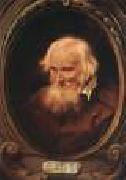 |
LIEVENS, Jan -- Click Here
|
|
Dutch painter (b. 1607, Leiden, d. 1674, Amsterdam)
Dutch painter, draughtsman and printmaker. His work has often suffered by comparison with that of Rembrandt, with whom he was closely associated from 1625 to 1631. Yet Lievens's early work is equal to that of Rembrandt, although in later years he turned more towards a somewhat facile rendering of the international Baroque style favoured by his noble patrons, thus never fully realizing his early promise. Nonetheless, he became a renowned portrait painter and draughtsman, and his drawings |
|
 |
Lieve Verschuier -- Click Here
|
|
(1627-1686) was a Dutch Golden Age painter of maritime subjects.
He was born in Rotterdam, and is documented in Amsterdam in 1651, where he possibly learned to paint from Simon de Vlieger. He traveled to Rome in 1653 as a young man with Jan Vermeer van Utrecht and became friends with Willem Drost and Johann Carl Loth.. On his return he settled in Rotterdam in 1667 where he remained, painting marine scenes, and Italianate landscapes.
His maritime works are valued today for their historical value illustrating the art of shipbuilding in the 17th century.
|
|
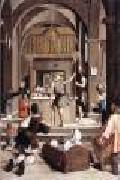 |
LIEFERINXE, Josse -- Click Here
|
|
French painter, Provençal school (active 1493-1508 in Marseille)
South Netherlandish painter, active in France. A native of Hainaut, in the diocese of Cambrai, he may have come from Lieferinge near Enghien (Claessens). He is documented in Marseille and Aix-en-Provence from 1493 to 1505, often being described as a 'Picard painter'. In 1503 he married Michelle, one of the daughters of Jean Changenet, the most prominent painter of the time in Avignon, with whom he may have trained. The last great representative of the 'School of Avignon', |
|
 |
Lie Louis Perin-Salbreux -- Click Here
|
|
French miniaturist , 1753-1817 |
|
 |
LICINIO, Bernardino -- Click Here
|
|
Italian painter, Venetian school (b. ca. 1489, Poscante, d. ca. 1565, Venezia) |
|
 |
Libri, Girolamo dai -- Click Here
|
|
Italian Painter, ca.1474-1555
Illuminator and painter, son of Francesco dai Libri. He was evidently trained by his father, but he received commissions for altarpieces as well as manuscripts. Documents indicate that he lived in Verona all his life, but an early miniature of the Nativity, the only work by him in a series of choir-books almost certainly painted in Ferrara, suggests that he may have spent some time there. Vasari's record that he worked as an illuminator in the monastery of S Salvatore in Candiana (Padua) may be true, as some of Girolamo's surviving miniatures were executed for the abbey. The only record of Girolamo's views on his art occurs in a register of 1544: 'a good and worthy painter must know how to imitate nature well and to feign that which nature makes, and he must be universal in depicting landscapes |
|
 |
Liberale da verona -- Click Here
|
|
Italian Early Renaissance Painter,
ca.1445-1530 |
|
|
|
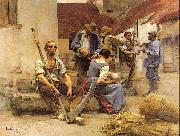 |
Lhermitte, Leon -- Click Here
|
|
French Realist Painter, 1844-1925
was a French painter and etcher of the late nineteenth century. A student of Lecocq de Boisbourdran, he was a realist artist whose primary subject matter was of rural scenes depicting the peasant worker. He gained recognition after his show in the Paris Salon in 1864. His many awards include the French Legion of Honour (1884) and the Grand Prize at the Exposition Universelle in 1889. Lhermitte's innovative use of the then contemporary media of pastels won him the admiration of his contemporaries. Vincent Van Gogh wrote that If every month Le Monde Illustr published one of his compositions... it would be a great pleasure for me to be able to follow it. It is certain that for years I have not seen anything as beautiful as this scene by Lhermitte |
|
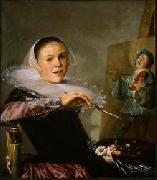 |
LEYSTER, Judith -- Click Here
|
|
Dutch Baroque Era Painter, 1609-1660
Dutch painter. A brewer's daughter, she had gained membership in the Haarlem painters' guild by age 24. Many of her known works, primarily portraits, genre paintings, and still lifes, were formerly attributed to her male contemporaries. Though the influence of Frans Hals is clear, she was also interested in the Baroque style of the Utrecht school. She embraced a greater range of subjects than other Dutch painters of the era |
|
 |
Levitsky, Dmitry -- Click Here
|
|
Russian Painter, 1735-1822
.Russian painter of Ukrainian birth. Together with Fyodor Rokotov and Vladimir Borovikovsky, he ranks foremost among 18th-century Russian portrait painters. He received his first lessons in painting from his father, Grigory Levitsky-Nos (1697-1769), a priest, engraver and painter. He also studied under Aleksey Antropov, who had come to Kiev to decorate St Andrew's church (1752-5). In the late 1750s Levitsky went with Antropov to St Petersburg, where he stayed until 1764; he continued with lessons from Antropov to whom, it appears, he owed the objectivity that was to characterize his work. It is probable that he also studied at the St Petersburg Academy of Arts, attending classes under Louis Lagren?e. Levitsky worked with Antropov on the decoration of triumphal arches in Moscow for Catherine II's coronation in 1762. His first known portraits are rather formal, for example that of the architect Aleksandr Kokorinov (1769; St Petersburg, Rus. Mus.), which won Levitsky the title of Academician in 1770. In such works he made successful use of a compositional structure typical of formal European portrait painting, intended to emphasize the importance of the sitter. |
|
 |
Levitan, Isaak -- Click Here
|
|
Russian Painter, 1860-1900
Russian painter of Lithuanian birth. He largely painted landscapes (including pastel sketches), which are noted for their emotive or symbolic resonance. His 'landscapes of mood' had a profound influence on Russian landscape painting, to which he introduced a sense of the unity of humankind and nature, and of the spiritual power of the Russian |
|
 |
Levi Wells Prentice -- Click Here
|
|
1850-1935
Levi Wells Prentice Gallery
Prentice was associated with the Hudson River School, a group of artists known throughout art circles. According to the book Nature Staged by Barbara Jones, Prentice followed a self-prescribed educational path, begun by the Hudson River School and reinforced by John Ruskin's (1819-1900) truth-to-nature principles laid out in his book Modern Painters. Although he can be allied to both schools of thought, Prentice can not be considered a member of either. This book has a photo of the artist in his early Brooklyn studio surrounded by his paintings and a complete essay on his life and work.
Levi grew up on a farm in Lewis County, New York. By 1872, Prentice had traveled through the Adirondack Mountains, painting the views as well as the surrounding region. He opened his first studio as a landscape painter in Syracuse, New York in 1875.
Self-taught artist Levi Wells Prentice is best known for his realistic still life compositions of fruit arranged within a landscape, or abundantly spilling from bushel baskets. Early in his career, he painted portraits and landscapes of the Adirondack Mountain region of Lewis County, New York, his birthplace.
Levi married an English woman Emma Roseloe Sparks in Buffalo, New York in 1882 and had two children, Leigh (born 22 March 1887) and Imogene (born 17 September 1889).
Prentice then turned to painting still life subjects when he moved briefly to Brooklyn, New York in 1883, focusing on fruit, in order of frequency apples, strawberries, peaches, plums, raspberries, cherries, muskmelons, pears, currants, pineapples, gooseberries, grapes and bananas usually piled high in pots or in natural settings.
Prentice subsequently moved around from 1903-07 before settling in the Germantown district of Philadelphia. However, his work did not gain much recognition with historians until the 1970s. He was a member of the Brooklyn Art Association and frequently exhibited his paintings there.
In addition to his artistic talents, he was a craftsman who enjoyed making his own brushes, palettes and frames.
In his painting, Prentice placed an emphasis on dark outlining with a concern for textual precision, creating dramatic contrasts. The shift between dark background areas and the vibrant hues of the fruit are done to give the compositions an exciting, visual energy. The fruit is presented with clarity and precision. An emphasis appears to be placed on the idea of man versus nature. The wooden baskets with hand-wrought nails represent a structured, man-made object, while the overly ripe fruit represents the fleeting qualities of nature. These paintings also demonstrate Prentice's remarkable skills at rendering color, form, and texture.
Noted art historian William H. Gerdts observed: there are several works by Prentice in which he achieves a quality of illusionism which is unsurpassed. In 1993, the skillful 'illusionism' of Levi Wells Prentice was celebrated in a retrospective exhibition at the Adirondack Museum in New York. His works continue to receive a high degree of appreciation by collectors today. He is represented in many museums including the New York State Museum, Museum of Fine Arts, Boston, Montclair Art Museum, Philbrook Museum of Art and Yale University Art Gallery.
Levi died 28 November 1935 in Germantown, Pennsylvania. |
|
 |
Lev Kamenev -- Click Here
|
|
Russian, 1833-1886
Russian political leader. A member of the Bolsheviks from 1903, he worked with Vladimir Ilich Lenin in Europe (1909 ?C 14), then returned to Russia, where he was arrested and sent to Siberia. After the Russian Revolution of 1917, he served as head of the Moscow soviet (1919 ?C 25). When Lenin became seriously ill in 1922, Kamenev joined Joseph Stalin and Grigory Y. Zinovyev to form the ruling triumvirate, attacking Leon Trotsky. In 1925 Stalin shifted his attack to Kamenev and Zinovyev, removng Kamenev as Moscow party head. In 1926 Kamenev was expelled from the party after conspiring with Zinovyev and Trotsky against Stalin. |
|
 |
Lev Feliksovich Lagorio -- Click Here
|
|
(Russian: 1828-1905) was a Russian painter, known for his paintings of seascapes.
Lagorio was born in Feodosia, Crimea (now Ukraine) and later studied in the Imperial Academy of Arts in Saint Petersburg. His teachers were Maxim Vorobiev and B. P. Villeval'de. While he lived in Feodosia, he was influenced by the painter Ivan Aivazovsky. In 1845 Lagorio went on a sea voyage on the warship Groziashchy to study the arrangement of the ship.
Lagorio spent eight years in Italy. The paintings he created there brought him to the status of professor on his return home to Russia.
In his later years, he painted the coastal views of Finland and Norway. He also painted motives of the Russian-Turkish war.
|
|
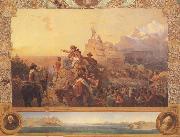 |
Leutze, Emmanuel Gottlieb -- Click Here
|
|
German-born American Romantic Painter, 1816-1868 |
|
 |
Lethiere, Guillaume Guillon -- Click Here
|
|
French Painter, 1760-1832 |
|
 |
lesueur -- Click Here
|
|
Charles Alexandre Lesueur (Le Havre, January 1, 1778 - Le Havre, December 12, 1846) was a French naturalist, artist and explorer.
Pictured here is the oil portrait by Charles Willson Peale of Charles-Alexandre Lesueur. The original hangs in the reading room of the of Ewell Sale Stewart Library in the Academy of Natural Sciences of Philadelphia.
In 1801 he traveled to Australia as artist on the expedition of Nicolas Baudin. With François Peron he took over the duties as naturalist after the death of the expedition's zoologist Rene Mauge. Together they collected over 100,000 zoological specimens.
Between 1815 and 1837 he lived in the United States In 1833, he visited Vincennes, Indiana where he sketched the first known drawing of Grouseland, the mansion of William Henry Harrison. The mansion is today a National Historic Landmark.
In the years 1825-1837 Lesueur lived in New Harmony, Indiana, where he filled sketchbooks full of the finds discovered during the utopian adventure funded by his friend William Maclure. He drew the boat "Philanthropist", which arrived full of intellectuals who came to live in the small town of New Harmony, on the Wabash River. He took research trips and sketched the people and the small towns in the area. He was in New Harmony when Prince Maximilian, Prince of Wied-Neuweid, Germany, and artist Karl Bodmer came to spend five months there in 1832-1833. Prince Maximilian said of Bodmer "He had explored the country in many directions, was acquainted with everything remarkable, collected and prepared all interesting objects and had already sent considerable collections to France" (Elliott Johansen, p. 6) Indeed, LeSeur sent specimens of unique fish, animals and fossils, as well as artifacts he had dug from the Indian Mounds in New Harmony back to France, where they remain.
LeSeur returned to France in 1837, only after his friends Thomas Say and Joseph Barabino had died and William MacClure had returned to Philadelphia, accompanied by many of his fine books. He had spent 21 years in the United States, but continued his scholarly studies and activities in France, where he resumed his occupation of artist-naturalist and began to catalogue his extensive research and artwork. At last, he was awarded the honor of Chevalier de l??Ordre Royal de la L??gion d'honneur for his long years of work in the sciences |
|
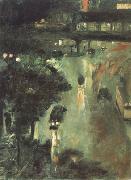 |
Lesser Ury -- Click Here
|
|
1861 - 1931
was a German Impressionist painter and printmaker. He was born Leo Lesser Ury in Birnbaum, the son of a baker whose death in 1872 was followed by the Ury family's move to Berlin. In 1878 Lesser left school to apprentice with a tradesman, and the next year he went to D??sseldorf to study painting at the Kunstakademie. Ury spent time in Brussels, Paris, Stuttgart, and other locations, before returning to Berlin in 1887. His first exhibition was in 1889 and met with a hostile reception, although he was championed by Adolph von Menzel whose influence induced the Academie to award Ury a prize. In 1893 he joined the Munich Secession, one of the several Secessions formed by progressive artists in Germany and Austria in the last years of the 19th century. In 1901 he returned to Berlin, where he exhibited with the Berlin Secession, first in 1915 and notably in 1922, when he had a major exhibition. By this time Ury's critical reputation had grown and his paintings and pastels were in demand. His subjects were landscapes, urban landscapes, and interior scenes, treated in an Impressionistic manner that ranged from the subdued tones of figures in a darkened interior to the effects of streetlights at night to the dazzling light of foliage against the summer sky. Ury is especially noted for his paintings of nocturnal cafe scenes and rainy streets. He developed a habit of repeating these compositions in order to sell them while retaining the originals, and these quickly made and inferior copies have harmed his reputation. |
|
 |
Leslie Ward -- Click Here
|
|
British Illustrator caricaturist and portrait painter , (1851-1922),
was a British portrait artist and caricaturist who drew or painted numerous portraits which were regularly published by Vanity Fair, under the pseudonym "Spy". Ward was one of eight children of artists Edward Matthew Ward and Henrietta Ward, and the great-grandson of the artist James Ward. Although they had the same surname before marriage, Ward's parents were not related. Both were well-known history painters, his mother coming from a line of painters and engravers, including her father, the engraver and miniature painter George Raphael Ward, and her grandfather, the celebrated animal painter James Ward. She was niece and great-niece respectively of the portrait painter John Jackson and the painter George Morland. Both parents had studios in their homes in Slough in Buckinghamshire and Kensington in London, where they regularly entertained the London artistic and literary elite. Ward's father was a gifted mimic who entertained Charles Dickens and other eminent guests. Although they never gave their son formal training, they and their artistic friends encouraged the young Ward to draw, paint, and sculpt.[1] Ward had started caricaturing while still at school at Eton in Windsor, using his classmates and school masters as subjects. In 1867 his bust of his brother was exhibited at the Royal Academy in London. At school Ward had been an unexceptional student, and after he left Eton in 1869 his father encouraged him to train as an architect. Ward was too afraid to tell his father that he wanted to be an artist and he spent an unhappy year in the office of the architect Sydney Smirke, who was a family friend. |
|
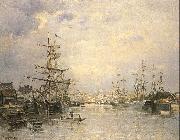 |
Lepine, Stanislas -- Click Here
|
|
French Impressionist Painter, 1836-1892 |
|
 |
LePICIeR, Nicolas-Bernard -- Click Here
|
|
French Painter, 1735-1784 |
|
 |
Lepicie, Nicolas Bernard -- Click Here
|
|
French Painter, 1735-1784 |
|
 |
Lepic Ludovic Napoleon -- Click Here
|
|
French ,
1839-1889
|
|
 |
Leopold Robert -- Click Here
|
|
(13 May 1794 - 20 March 1835), Swiss painter, was born at La Chaux-de-Fonds (Neuchâtel) in Switzerland, but left his native place with the engraver Girardet at the age of sixteen for Paris.
He was on the eve of obtaining the grand prix for engraving when the events of 1815 blasted his hopes, for Neuchâtel was restored to Prussia, and Robert was struck off the list of competitors as a foreigner. Whilst continuing his studies under Girardet he had never ceased to frequent the studio of David, and he now determined to become a painter, and only returned to his native country when his master himself was exiled. At Neuchâtel he attracted the notice of Roullet de Mezerac, who enabled him by a timely loan to proceed to Rome. In depicting the customs and life of the people, of southern Italy especially, he showed peculiar feeling for the historical characteristics of their race.
After executing many detached studies of Italian life Robert conceived the idea of painting four great works which should represent at one and the same time the four seasons in Italy and the four leading races of its people. In the "Return from the Fete of the Madonna dell'Arco" (Louvre) he depicted the Neapolitans and the spring. This picture, exhibited at the Salon of 1827, achieved undoubted success and was bought for the Luxembourg by Charles X; but the work which appeared in 1831 the "Summer Reapers arriving in the Pontine Marshes" (Louvre), which became the property of Louis Philippe established the artist's reputation.
Florence and her autumn vineyards should now have furnished him with his third subject. He attempted to begin it, but, unable to conquer his passion for Princess Charlotte Napoleon (then mourning the violent death of her husband, Robert's devoted friend), he threw up his work and went to Venice, where he began and carried through the fourth of the series, the "Fishers of the Adriatic." This work was not equal to the "Reapers." Worn by the vicissitudes of painful feeling, and bitterly discouraged, Robert committed suicide before his easel on 20 March 1835, on the tenth anniversary of the melancholy suicide of a brother to whom he had been much attached.
|
|
|
|
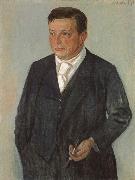 |
Leopold Graf Von Kalckreuth -- Click Here
|
|
1855-1928,German painter and etcher. The son of the late Romantic landscape painter Eduard Stanislaus, Graf von Kalckreuth (1820-94), he studied from 1875 to 1878 under Ferdinand Schauss (1832-1916), Willem Linnig (1819-85) and Alexander Struys (1852-1941) at the Kunstschule in Weimar founded by his father. In 1879, after military service, he enrolled at the Akademie in Munich, where he attended Gyula Benczer's drawing classes and continued his study of painting under Karl Theodor von Piloty and Wilhelm von Diez (1839-1907). In 1883 he travelled to the Netherlands and then to Italy and France. In 1885 he accepted a teaching appointment at the Kunstschule in Weimar, but in 1890 he resigned and returned to Munich. During the next five years he worked at Heckricht in Silesia (now Jedrzychowice, Poland), perfecting his oil technique. In 1892 he was a founder-member of the Munich Secession. Kalckreuth's work from this period reflects the influence of several contemporaries; the portrait of the Artist's Wife of 1888 (Leipzig, Mus. Gesch.) recalls the portraits of Franz von Lenbach and Max Liebermann, while the visionary element brought to the genre scene Rainbow (1894-6; Munich, Neue Pin.) is close to the work of Fritz von Uhde. |
|
 |
Leopold Carl Muller -- Click Here
|
|
Austrian
born 1834 - died 1892 |
|
 |
Leonor de Almeida Portugal -- Click Here
|
|
Leonor de Almeida Portugal de Lorena e Lencastre (Lisboa, 31 de outubro de 1750 - Benfica, 11 de outubro de 1839) foi uma nobre e poetisa portuguesa. |
|
 |
Leonhard Beck -- Click Here
|
|
German Northern Renaissance Painter, ca.1480-1542, Illuminator, painter, draughtsman and woodcutter, son of Georg Beck. He first appears as an illuminator and collaborator with his father in two Psalters for the Augsburg monastery of SS Ulrich and Afra in 1495, producing 35 coloured initial letters for each of them (Augsburg, Staats- & Stadtbib., Cod. 49a). These are vigorously coloured but fairly uniform in character, with small, lively biblical scenes excellently adapted to the letters. Red, green and blue predominate; ochre tones provide a link with the gold ground. The initial letter X is composed of splendidly curled, entwining foliage with birds and half-figures of prophets; the Virgin, Joseph, the Christ Child in the manger and the choir of angels are each enclosed in one of its sectors. The figures are presented in a light, easy manner; the draughtsmanship avoids unnecessary detail. |
|
 |
LEONARDO da Vinci -- Click Here
|
|
Italian High Renaissance Painter and Inventor, 1452-1519
Italian High Renaissance Painter and Inventor, 1452-1519 Florentine Renaissance man, genius, artist in all media, architect, military engineer. Possibly the most brilliantly creative man in European history, he advertised himself, first of all, as a military engineer. In a famous letter dated about 1481 to Ludovico Sforza, of which a copy survives in the Codice Atlantico in Milan, Leonardo asks for employment in that capacity. He had plans for bridges, very light and strong, and plans for destroying those of the enemy. He knew how to cut off water to besieged fortifications, and how to construct bridges, mantlets, scaling ladders, and other instruments. He designed cannon, very convenient and easy of transport, designed to fire small stones, almost in the manner of hail??grape- or case-shot (see ammunition, artillery). He offered cannon of very beautiful and useful shapes, quite different from those in common use and, where it is not possible to employ cannon ?? catapults, mangonels and trabocchi and other engines of wonderful efficacy not in general use. And he said he made armoured cars, safe and unassailable, which will enter the serried ranks of the enemy with their artillery ?? and behind them the infantry will be able to follow quite unharmed, and without any opposition. He also offered to design ships which can resist the fire of all the heaviest cannon, and powder and smoke. The large number of surviving drawings and notes on military art show that Leonardo claims were not without foundation, although most date from after the Sforza letter. Most of the drawings, including giant crossbows (see bows), appear to be improvements on existing machines rather than new inventions. One exception is the drawing of a tank dating from 1485-8 now in the British Museum??a flattened cone, propelled from inside by crankshafts, firing guns. Another design in the British Museum, for a machine with scythes revolving in the horizontal plane, dismembering bodies as it goes, is gruesomely fanciful. Most of the other drawings are in the Codice Atlantico in Milan but some are in the Royal Libraries at Windsor and Turin, in Venice, or the Louvre and the École des Beaux Arts in Paris. Two ingenious machines for continuously firing arrows, machine-gun style, powered by a treadmill are shown in the Codice Atlantico. A number of other sketches of bridges, water pumps, and canals could be for military or civil purposes: dual use technology. Leonardo lived at a time when the first artillery fortifications were appearing and the Codice Atlantico contains sketches of ingenious fortifications combining bastions, round towers, and truncated cones. Models constructed from the drawings and photographed in Calvi works reveal forts which would have looked strikingly modern in the 19th century, and might even feature in science fiction films today. On 18 August 1502 Cesare Borgia appointed Leonardo as his Military Engineer General, although no known building by Leonardo exists. Leonardo was also fascinated by flight. Thirteen pages with drawings for man-powered aeroplanes survive and there is one design for a helicoidal helicopter. Leonardo later realized the inadequacy of the power a man could generate and turned his attention to aerofoils. Had his enormous abilities been concentrated on one thing, he might have invented the modern glider. |
|
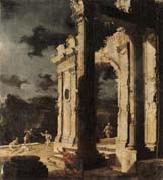 |
Leonardo Coccorante -- Click Here
|
|
Italian, 1680-1750 , Active in Naples during the frist half of the 18th Century
Active in Naples during the frist half of the 18th Century .was an Italian painter who was born in Naples, Italy. He studied with Jan Frans van Bloemen (1662-1749), Angelo Maria Costa (1670-1721), and finally with Gabriele Ricciardelli (active between 1741 and 1777). From 1737 to 1739, he was employed decorating the royal palace of Naples. Coccorante died in Naples in 1750. He is best known for his large highly detailed landscapes with imaginary classical architectural ruins. He often included small figures in the foreground to emphasize the expansiveness of the ruins. Coccorante is classified as a veduta (or vista) painter. The Honolulu Academy of Arts, the Louvre, the Lowe Art Museum (Coral Gables, Florida.), Mus??e d??partemental de l'Oise (Beauvais, France), Mus??e de Grenoble (Grenoble, France), Museo Regionale Agostino Pepoli (Trapani, Italy), and Pinacoteca del Castello Sforzesco (Milan, Italy) |
|
 |
Leonardo Bazzaro -- Click Here
|
|
(Milan, 1853-1937) was an Italian painter.
After picking up the basics in the studio of the painter Gaetano Fasanotti, Bazzaro enrolled at the Brera Academy in Milan, where he was awarded the Fumagalli Prize in 1875. The following years saw a series of perspective views set in Milanese churches and mansions. The success achieved with the public and critics alike at a number of major national and international events prompted him to take an interest also in portraiture and landscape painting, for which his favourite settings were Venice and Chioggia. The works of the 1880s and 1890s also include increasingly intimist scenes of everyday life in the setting of Valsassina, Valle deAosta and Verbano. Bazzaro continued to take part in numerous exhibitions in the region of Lombardy as well as the Venice Biennale and the Rome Quadrenniale right up to his death, always achieving great success with collectors and being asked to execute replicas of his most popular subjects.
|
|
 |
Leonardo Alenza Y Nieto -- Click Here
|
|
b Madrid, 6 Nov 1807; d Madrid, 30 June 1845
Spanish painter and illustrator. He studied at the Real Academia de S Fernando, Madrid, under Juan Antonio Ribera y Fern?ndez and Jos? de Madrazo y Agudo. He worked independently of court circles and achieved some fame but nevertheless died in such poverty that his burial was paid for by friends. He is often described as the last of the followers of Goya, in whose Caprichos and drawings he found inspiration for the genre scenes for which he became best known. Of these scenes of everyday life and customs the more interesting include The Beating (Madrid, Cas?n Buen Retiro) and Galician with Puppets (c. 1835; Madrid, Cas?n Buen Retiro; see SPAIN, fig. 17). Alenza y Nieto's numerous drawings include the illustrations for Alain-Ren? Lesage's Gil Blas (Madrid, 1840), for an edition of the poems of Francisco de Quevedo published by Castello and for the reviews Semanario pintoresco and El Reflejo. The painting Triumph of David |
|
 |
Leonardo Da Vinci -- Click Here
|
|
Italian High Renaissance Painter and Inventor, 1452-1519
Florentine Renaissance man, genius, artist in all media, architect, military engineer. Possibly the most brilliantly creative man in European history, he advertised himself, first of all, as a military engineer. In a famous letter dated about 1481 to Ludovico Sforza, of which a copy survives in the Codice Atlantico in Milan, Leonardo asks for employment in that capacity. He had plans for bridges, very light and strong, and plans for destroying those of the enemy. He knew how to cut off water to besieged fortifications, and how to construct bridges, mantlets, scaling ladders, and other instruments. He designed cannon, very convenient and easy of transport, designed to fire small stones, almost in the manner of hail??grape- or case-shot (see ammunition, artillery). He offered cannon of very beautiful and useful shapes, quite different from those in common use and, where it is not possible to employ cannon ?? catapults, mangonels and trabocchi and other engines of wonderful efficacy not in general use. And he said he made armoured cars, safe and unassailable, which will enter the serried ranks of the enemy with their artillery ?? and behind them the infantry will be able to follow quite unharmed, and without any opposition. He also offered to design ships which can resist the fire of all the heaviest cannon, and powder and smoke.
The large number of surviving drawings and notes on military art show that Leonardo claims were not without foundation, although most date from after the Sforza letter. Most of the drawings, including giant crossbows (see bows), appear to be improvements on existing machines rather than new inventions. One exception is the drawing of a tank dating from 1485-8 now in the British Museum??a flattened cone, propelled from inside by crankshafts, firing guns. Another design in the British Museum, for a machine with scythes revolving in the horizontal plane, dismembering bodies as it goes, is gruesomely fanciful.
Most of the other drawings are in the Codice Atlantico in Milan but some are in the Royal Libraries at Windsor and Turin, in Venice, or the Louvre and the École des Beaux Arts in Paris. Two ingenious machines for continuously firing arrows, machine-gun style, powered by a treadmill are shown in the Codice Atlantico. A number of other sketches of bridges, water pumps, and canals could be for military or civil purposes: dual use technology.
Leonardo lived at a time when the first artillery fortifications were appearing and the Codice Atlantico contains sketches of ingenious fortifications combining bastions, round towers, and truncated cones. Models constructed from the drawings and photographed in Calvi works reveal forts which would have looked strikingly modern in the 19th century, and might even feature in science fiction films today. On 18 August 1502 Cesare Borgia appointed Leonardo as his Military Engineer General, although no known building by Leonardo exists.
Leonardo was also fascinated by flight. Thirteen pages with drawings for man-powered aeroplanes survive and there is one design for a helicoidal helicopter. Leonardo later realized the inadequacy of the power a man could generate and turned his attention to aerofoils. Had his enormous abilities been concentrated on one thing, he might have invented the modern glider. |
|
 |
Leonard Defrance -- Click Here
|
|
Flemish Painter, 1735-1805 |
|
 |
Leonaert Bramer -- Click Here
|
|
(24 December 1596 - 10 February 1674 (buried)) was a Dutch painter, best known for probably being one of the teachers of Johannes Vermeer, although there is no similarity between their work. Bramer's dark and exotic style is unlike Vermeer's style. Bramer was primarily a genre and history painter, but also made some unique frescos, not very often found north of the Alps. Leonaert Bramer is one of the most intriguing personalities in seventeenth-century Dutch art. He was a talented and diligent draughtsman, evidently Roman Catholic and a lifelong bachelor.
Bramer was born in Delft. In 1614, at the age of 18, he left on a long trip eventually reaching Rome in 1616, via Atrecht, Amiens, Paris, Aix (February 1616), Marseille, Genoa, and Livorno. In Rome he was one of the founders of the Bentvueghels group of Northern artists. He lived with Wouter Crabeth and got into a fight with Claude Lorraine. He dedicated a poem to Wybrand de Geest. Bramer remained on and off in Rome until October 1627, visiting Mantua and Venice, often for deliveries and to meet Domenico Fetti. In Italy Bramer was nicknamed Leonardo della Notte ("Leonardo of the night"). In 1648 he went to Rome for a second time.
By 1628 he was back in Delft, where he joined the Guild of Saint Luke in 1629 and the schutterij. Among his many patrons were members of the House of Orange, but local burgomasters and schepen also bought his paintings in great numbers.[3] He was a many sided artist, designing for tapestry firms in Delft, painting murals and ceilings, some of which are illusionistic in style. He painted real frescos in the Civic Guard house, the nearby stadholder's palaces in Honselersdijk, Rijswijk, the Communal Land Housde and the Prinsenhof in Delft.[3] Due to the Dutch climate they no longer survive.
He evidently knew the greatest of his Delft contemporaries, Johannes Vermeer, as he came to the latter's defence when his future mother-in-law was trying to prevent him from marrying her daughter.
|
|
 |
Leon-Matthieu Cochereau -- Click Here
|
|
1793-1817
French
Leon-Matthieu Cochereau Location |
|
 |
Leon-Jules Lemaitre -- Click Here
|
|
painted Le Pont Corneille, Rouen in 1890 |
|
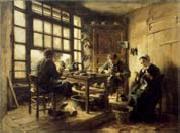 |
Leon Lhermitte -- Click Here
|
|
1844-1925 was a French painter and etcher of the late nineteenth century. A student of Lecocq de Boisbourdran, he was a realist artist whose primary subject matter was of rural scenes depicting the peasant worker. He gained recognition after his show in the Paris Salon in 1864. His many awards include the French Legion of Honour (1884) and the Grand Prize at the Exposition Universelle in 1889. Lhermittees innovative use of the then contemporary media of pastels won him the admiration of his contemporaries. Vincent Van Gogh wrote that. If every month Le Monde Illustre published one of his compositions. |
|
 |
Leon Kaplinski -- Click Here
|
|
(1824-1873) was a Polish painter and political activist.
Born 1824 in Lisew not far from Warsaw, Leon was the son of a small landowner and an eminent freemason Jan Kaplieski. The Kaplieskis were a Frankist family; his grandfather Eliasz Adam Kaplieski was one of the last known Frankists. Leon Kaplieski studied law and philosophy in Warsaw and Wrocław (Breslau). He was engaged in revolutionary underground groups, fled from the part of Poland under Russian rule, was briefly held and interrogated by the Prussian police, and took part in the revolutionary movement in 1848. In the same year Kaplieski emigrated to Paris where he spent most of his remaining years. He took part in Polish emigre political activities, closely connected with the circle of Hotel Lambert and the Czartoryski family, accompanied the Count Witold Czartoryski during his trip to the Balkans and the Near East. Kaplieski also edited the periodical Ephemerides Polonaises. He was married to Helena Hryniewiecka. In 1871 he moved back to Poland, living mostly in Krakew, and died in 1873 in Milosław. He befriended several well-known Polish artists and writers, including Henryk Rodakowski, Jan Matejka, and Cyprian Kamil Norwid.
Kaplieski studied art in Poland and later in Paris. His first known works are copies of paintings by famous Italian artists; later he became known and appreciated for his patriotic historical paintings as Wernyhora (1855). His best works are portraits: of his mother Julia (1860), the writer Bohdan Zaleski (1857), Count Adam Jerzy Czartoryski (about 1860), and an autoportrait as a Templar (about 1872). Many of his paintings and other works have perished or been lost. Mainly influenced by classical Italian art and his contemporary Rodakowski, L.K. continued the tradition of academic painting and had no interest for the emerging modernist tendencies of the mid-nineteenth century. He won some recognition in France, participating in the Paris art salons. L.K. wrote some poems and a short novel Nad Wisłą (On Wisla).
|
|
 |
Leon Joseph Florentin Bonnat -- Click Here
|
|
(20 June 1833 - 8 September 1922) was a French painter.
He was born in Bayonne, but from 1846 to 1853 he lived in Madrid, where his father owned a bookshop. While tending his father's shop, he copied engravings of works by the Old Masters, developing a passion for drawing. In Madrid he received his artistic training under Madrazo. He later worked in Paris, where he became known as a leading portraitist, never without a commission. His many portraits show the influence of Velezquez, Jusepe de Ribera and other Spanish masters, as well as Titian and Van Dyke, whose works he studied in the Prado. Following the period in Spain Bonnat worked the ateliers of the history painters Paul Delaroche and Leon Cogniet (1854) in Paris. Despite repeated attempts, he failed to win the prix de Rome, finally receiving only a second prize. However, a scholarship from his native Bayonne allowed him to spend three years in Rome (1858 - 60) independently. During his stay in Rome, he became friends with Edgar Degas, Gustave Moreau, Jean-Jacques Henner and the sculptor Henri Chapu.
He won a medal of honor in Paris in 1869, going on to become one of the leading artists of his day. Bonnat went on to win the Grand Officer of the Legion d'honneur and became a professor at the Ecole des Beaux Arts in 1882. Bonnat was quite popular with American students in Paris. In addition to his native French, he spoke Spanish and Italian and knew English well, to the relief of many monolingual Americans. In May 1905 he succeeded Paul Dubois as director of the Ecole des Beaux-Arts. Bonnat "was a liberal teacher who stressed simplicity in art above high academic finish, as well as overall effect rather than detail," explains Julius Kaplan (see References). Bonnat's emphasis on overall effect on the one hand, and rigorous drawing on the other, put him in a middle position with respect to the Impressionists and academic painters like his friend Jean-Leon Gerôme.
|
|
|
|
 |
Leon Comerre -- Click Here
|
|
Leon François Comerre French. 1850 - 1934 |
|
 |
Leon Cogniet -- Click Here
|
|
French Academic Painter, 1794-1880,was a French painter. Cogniet was born in Paris. In 1812, he entered the Ecole des Beaux-Arts in Paris, where he studied under Pierre-Narcisse Guerin at the same time as Delacroix and Gericault. He was a resident at the Villa Medici, in Rome, from 1817 to 1822. A romantic painter, his main subjects were history and portraits, and in 1817 he won the Prix de Rome. He died in Paris in 1880. |
|
 |
Leon Bonnat -- Click Here
|
|
French Academic Painter, 1833-1922,was a French painter. He was born in Bayonne, but from 1846 to 1853 he lived in Madrid, Spain, where his father owned a bookshop. In Madrid he received his artistic training under Madrazo. He later worked in Paris, where he became known as a leading portraitist. His many portraits show the influence of Velazquez and the Spanish realists. He won a medal of honor at Paris in 1869, where he became one of the leading artists of his day. Bonnat went on to become a professor at the Ecole des Beaux Arts in 1882. In May 1905 he succeeded Paul Dubois as director. His vivid portrait-painting is his most characteristic work, but his subject pictures, such as the Martyrdom of St Denis in the Pantheon, are also famous. Some of Bonnat's more notable students include: Gustave Caillebotte, Suzor-Cote, Georges Braque,Raoul Dufy, Marius Vasselon, Fred Barnard, |
|
 |
Leon Benouville -- Click Here
|
|
Paris 1821 - Paris 1859.
was a French painter. Leon Benouville first studied with his elder brother Jean-Achille Benouville (1815-1891) in the studio of François-Edouard Picot before he transferred to Ecole des Beaux-Arts in 1837. Like his brother he received the Prix de Rome in 1845. In Rome, as a Prix de Rome pensionary at the Villa Medici, he stayed with his brother and met the sculptor Charles Gumery. |
|
 |
leon belly -- Click Here
|
|
French Academic Painter, 1827-1877 |
|
 |
Leon Bazille Perrault -- Click Here
|
|
(20 June 1832, Poitiers - 1908, Royan) was a French painter.
A student of William Bouguereau and François-Edouard Picot, he exhibited at the Salon from 1863 onwards, producing several works, in the academic tradition. He was famous for his le petit naufrag (The little shipwrecked boy, 1874) and his paintings of children.
|
|
 |
Leon Bakst -- Click Here
|
|
Russian Art Deco Designer and Illustrator, 1866-1924 |
|
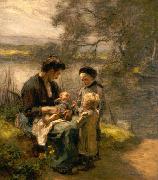 |
Leon Augustin Lhermitte -- Click Here
|
|
(1844 - 1925) was a French realist painter and etcher whose primary subject matter was of rural scenes depicting the peasant worker.
He was born in Mont-Saint-Pere. A student of Lecoq de Boisbaudran, he gained recognition after his show in the Paris Salon in 1864.
His many awards include the French Legion of Honour (1884) and the Grand Prize at the Exposition Universelle in 1889. Lhermitte died in Paris in 1925.
Lhermittees innovative use of pastels won him the admiration of his contemporaries. Vincent Van Gogh wrote that eIf every month Le Monde Illustre published one of his compositions ... it would be a great pleasure for me to be able to follow it. It is certain that for years I have not seen anything as beautiful as this scene by Lhermitte ... I am too preoccupied by Lhermitte this evening to be able to talk of other things.e
Lhermitte's etchings and paintings are housed in museums around the world including Boston, Washington, Chicago, Montreal, Brussels, Rheims, Paris, Moscow and Florence.
|
|
 |
Leo-Paul Robert -- Click Here
|
|
impression atist
1851?C1923 |
|
 |
Leo von Klenze -- Click Here
|
|
German Architect and Painter, 1784-1864,was a German neoclassicist architect, painter and writer. Court architect of Bavarian King Ludwig I, Leo von Klenze was one of the most prominent representatives of Greek revival style. Von Klenze studied architecture in Berlin and Paris. Between 1808 and 1813 he was a court architect of Jerome Bonaparte, King of Westphalia. Later he moved to Bavaria and in 1816 began to work as court architect of Ludwig I. The King's passion for Hellenism shaped the architectural style of von Klenze. He built many neoclassical buildings in Munich, including the Ruhmeshalle and Monopteros temple. On Konigsplatz he designed probably the best known modern Hellenistic architectural ensemble. Near Regensburg he built the Walhalla temple, named after Valhalla, the home of gods in Norse mythology. When Greece won its independence, Ludwig I's son Otto became the country's first king. Von Klenze was invited to Athens to submit plans of city reconstruction in the style of Ancient Greece. Russian Emperor Nicholas I commissioned von Klenze to design a building for the New Hermitage, a public museum that housed Greek, Roman, and Egyptian antiquities. Von Klenze also designed and arranged museum galleries in Munich, including the Glyptothek and Alte Pinakothek. Von Klenze was not only an architect, but also an accomplished painter and draughtsman. In many of his paintings ancient buildings were depicted. Those served as models for his own architectural projects. Klenze studied ancient architecture during his travels to Italy and Greece. He also participated in excavations of ancient buildings in Athens and submitted projects for the restoration of the Acropolis. Klenze collected works of important contemporary German painters. He sold his collection, including 58 landscapes and genre paintings, to King Ludwig I in 1841. |
|
 |
Leo Putz -- Click Here
|
|
Germany (1869 -1940 ) - Painter
|
|
 |
Leo Gestel -- Click Here
|
|
Leo Gestel (11 November 1881, Woerden- 26 November 1941, Hilversum) was a Dutch painter. His father Willem Gestel was also an artist. Leo Gestel experimented with cubism, expressionism, futurism and postimpressionism. Along with Piet Mondrian he was among the leading artists of Dutch modernism. |
|
 |
LENS, Andries Cornelis -- Click Here
|
|
Flemish painter (b. 1739, Antwerpen, d. 1822, Bruxelles).
Flemish painter and writer. He was the son of the flower painter Cornelis Lens (d after 1766) and studied first under Charles Ykens II (1719-53) and then under Balthazar Beschey. In 1756 he was awarded first prize at the Academie of Antwerp and in 1763 was appointed to the staff on the strength of his decoration (destr.) of the refectory of the Alexians at Lier. He also came to the attention of Charles Alexandre, Duke of Lorraine and Bar, Governor-General of the Netherlands |
|
 |
lennart nilsson -- Click Here
|
|
1992, intestines of a new-born baby . colour photograph. lennart nilsson photography ab, stockholm |
|
 |
Lemuel Francis Abbott -- Click Here
|
|
1760-1803
Lemuel Francis Abbott Locations
English painter. He was the son of a clergyman and went to London to study with Francis Hayman shortly before the latter death in 1776; he may have completed his studies in Derby with Joseph Wright of Derby. By the early 1780s Abbott had established a busy portrait practice in London. The formula he adopted for most of his head-and-shoulder portraits can be seen in Sir William Herschel (1785; London, N. Mar. Mus.): the body is parallel to the picture plane, and the sitter head is moved into three-quarter profile, as if his attention has been suddenly distracted. In later portraits, such as those of fellow artists Francesco Bartolozzi (c. 1792; London, Tate) or Joseph Nollekens (c. 1797; London, N.P.G.), the sitter hand or some attribute balances the movement of the head. Only male portraits by Abbott are known, and his patrons were mostly drawn from the professional classes, particularly the Navy; there are several versions of Lord Nelson (e.g. 1798; London, N. Mar. Mus.). His style is crisp but scratchy in technique, and often the anatomy of his figures is inaccurate. Paint is handled in a manner comparable with that of Gainsborough Dupont, but Abbott sense of composition is superior. In 1798 he was certified insane, but he continued to exhibit at the Royal Academy in London for two further years. Several of his works were probably finished by another hand. |
|
 |
Lemmen, Georges -- Click Here
|
|
Belgian Art Nouveau Painter, 1865-1916
Belgian painter and decorative artist. He showed a precocious talent, first exhibiting in 1875. His only formal study was at a local school of drawing. Between 1884 and 1886 he showed at the Essor group in Brussels paintings that were based on Derer and Holbein and closely related to those of Lemmen's contemporary, Khnopff. When Lemmen became a member of Les XX in 1888 his style developed quickly, influenced principally by French Neo-Impressionism and the English Arts and Crafts Movement. Lemmen adopted the pointillist technique following Seurat's first showing with Les XX in 1887. His best pointillist canvases include The Carousel (1890-91; Toulon, Mme Thevenin-Lemmen priv. col., see Belgian Art, 1880-1914, exh. cat., New York, Brooklyn |
|
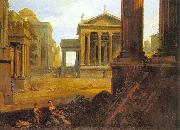 |
Lemaire, Jean -- Click Here
|
|
1763-64, oil on canvas, The Hermitage, St. Petersburg |
|
 |
LELY, Sir Peter -- Click Here
|
|
Dutch/English painter (b. 1616, Soest, d. 1680, London
Dutch painter, draughtsman and collector, active in England. By a combination of ability and good fortune, he rapidly established himself in mid-17th-century London as the natural successor in portrait painting to Anthony van Dyck. Between van Dyck's death in 1641 and the emergence of William Hogarth in the 1730s, Lely and his successor, Godfrey Kneller, were the leading portrait painters in England. After the restoration of the monarchy in 1660, Lely dominated the artistic scene, and his evocation of the court of Charles II is as potent and enduring as was van Dyck's of the halcyon days before the English Civil War. Although Lely's reputation was seriously damaged by portraits that came from his studio under his name but without much of his participation, his development of an efficient studio practice is of great importance in the history of British portrait painting. The collection of pictures, drawings, prints and sculpture |
|
 |
leigh hunt -- Click Here
|
|
British writer who defended the romanticism of Keats and Shelley (1784-1859)
Synonyms: Hunt, James Henry Leigh Hunt |
|
 |
LEICHER, Felix Ivo -- Click Here
|
|
Austrian painter
b. 1727, Wagstadt, d. 1812, Wien |
|
 |
Leibl, Wilhelm -- Click Here
|
|
German Realist Painter, 1844-1900
German painter, draughtsman and etcher. In 1861 he abandoned his apprenticeship as a locksmith in order to train as a precision instrument maker, though a month or so later he decided to train as an artist, at first under the Cologne history painter and writer Hermann Becker (1817-85). In 1863 he moved to Munich; he studied there from March 1864, at the Akademie der Bildenden K?nste, initially under Philipp von Foltz and Alexander Straehuber, drawing from plaster casts, and later in Hermann Ansch?tz's painting class. Here, Arthur von Ramberg (1819-75) stimulated Leibl's sensitivity to colour; and Karl Theodor von Piloty encouraged him to observe reality and incorporate its lessons boldly into compositions on historical themes. From the start, however, Leibl tended to think of his pictures in terms of form rather than content. While at the Akademie he first reached a standard of excellence with his draughtmanship, which is notable for its directness and objectivity. As an artist, Leibl's early works were not especially promising. However, as occurred throughout his career, a long period of mediocrity was crowned by an unexpected masterpiece, such as his portrait drawing of Aunt Josepha (c. 1864; Cologne, Wallraf-Richartz-Mus.). This is particularly striking for Leibl's use of the hands to add to the expression of the sitter's character and mood, a device he was to use frequently in later work. In Munich, Leibl supplemented the teaching of the Akademie by studying the works of the Old Masters in the Alte Pinakothek: he paid particular attention to painters of the Baroque period such as van Dyck, Cornelis de Vos and Rubens, and also to other great masters of portraiture such as Frans Hals and Vel?zquez. The presentation of the subject found in such works is reflected in Leibl's portrait of Frau Gedon (1869; Munich, Neue Pin.). When the work was shown at the Grossen Internationale Kunstausstellung in Munich in 1869 it was singled out as the best oil painting of the exhibition by Gustave Courbet and, as a result, Leibl was honoured with an invitation to Paris, where he arrived on 13 November 1869. |
|
 |
Legros, Alphonse -- Click Here
|
|
French-born British Painter and Sculptor, 1837-1911
British etcher, painter, sculptor and teacher of French birth. He is said to have been apprenticed at the age of 11 to a sign-painter, at which time he may also have attended classes at the Ecole des Beaux-Arts in Dijon. He was employed as assistant on a decorative scheme in Lyon Cathedral before moving in 1851 to Paris, where he worked initially for the theatre decorator C. A. Cambon (1802-75). He soon became a pupil of Horace Lecoq de Boisbaudran, whose methodical instruction and liberality in fostering individual talent proved of lasting benefit to Legros. In 1855 he enrolled at the Ecole des Beaux-Arts, Paris, attending irregularly until 1857. During this period Legros had a taste for early Netherlandish art and for French Romanticism, which was later superseded by his admiration for Claude, Poussin and Michelangelo. |
|
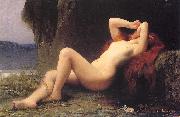 |
Lefebvre, Jules Joseph -- Click Here
|
|
French, 1834-1912 |
|
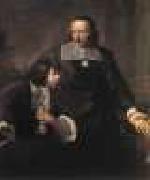 |
LEFEBVRE, Claude -- Click Here
|
|
French painter (b. 1637, Fontainebleau, d. 1675, Paris |
|
 |
Leemput, Remigius van -- Click Here
|
|
Flemish Baroque Era Painter, 1607-1675 |
|
 |
LEDESMA, Blas de -- Click Here
|
|
Spanish painter documented 1602-1614 in Granada,Spanish painter. He is known to have worked in Granada from 1602, and in 1614 he designed a stucco vault decoration for the Alhambra. Archival sources testify to his renown as a painter of decorative fresco grotesques (untraced) and still-lifes. His activity as a still-life painter remains debatable, partly because he has been confused with Blas de Prado and also because of Torres Marten's controversial attributions. Ledesma's only unanimously accepted autograph painting is Still-life with Cherries and Flowers (Atlanta, GA, High Mus. A.), signed in Granada. A highly decorative painting, it shows none of the sophistication of still-lifes by Juan Senchez Cot?n, in Granada from 1603. It is painted meticulously and drily. Depicting a severely drawn, rather flat basket on a narrow ledge flanked by flowers behind it, the rigorously symmetrical composition is relieved only by soft lighting and the studied disarray of some fallen cherries. Two other unsigned and poorly preserved still-lifes of analogous subject-matter have been attributed to Ledesma |
|
 |
Lebasque, Henri -- Click Here
|
|
French Painter, 1865-1937
was born in 1865 at Champign (Maine-et-Loire). He started his education at the Ecole des Beaux-Arts d'Angers, and moved to Paris in 1886. Here, Lebasque started studying under Leon Bonnat, and assisted Humbert with the decorative murals at the Pantheon. Around this time, Lebasque met Camille Pissarro and Auguste Renoir, who later would have a large impact on his work. Lebasque's vision was coloured by his contact with younger painters, especially Edouard Vuillard and Pierre Bonnard, founders of the The Nabis' Group and the Intimists who first favoured the calm and quietude of domestic subject matter. From his first acquaintance with Georges Seurat and Paul Signac, Lebasque learnt the significance of a colour theory which stressed the use of complementary colours in shading. Lebasque was a founding member of the Salon d'Automne in 1903 with his friend Henri Matisse. Two years later a group of artists exhibited there including Georges Rouault, Andre Derain, Edouard Vuillard and Henri Matisse while keeping solid links with other artists such as Gustave Rouault, Raoul Dufy, Louis Valtat and especially Henri Manguin, who made him discover the south of France. His time in South of France would lead to a radical transformation in Lebasque's paintings, changing his colour palette forever. Other travels included the Vendee, Normandie and Brittany, although Lebasque would always prefer the small idyllic villages of the South of France. Lebasque had some commercial success during his lifetime. He worked on the decorations at the theatre of the Champs-Elyses and of the Transatlantique sealiner. |
|
 |
Lear, Edward -- Click Here
|
|
English Painter and Illustrator, 1818-1888
English painter, draughtsman, illustrator and writer. In the 1860s Lear described himself as 'Greek Topographical Painter par excellence', aspiring to the title of 'Painter-Laureate and Boshproducing-Luminary forthwith' (quoted in 1983 exh. cat., p. 14). This whimsical summary of his versatile activities as topographical draughtsman, oil painter, traveller, writer and illustrator of nonsense rhymes and stories is typical of Lear's idiosyncratic literary style. It reflected his eccentric personality. He was epileptic and prone to fits of deep depression. In addition, owing to family misfortunes, |
|
 |
LE SUEUR, Eustache -- Click Here
|
|
French painter (b. 1616/17, Paris, d. 1655, Paris).
French painter and draughtsman. He was one of the most important painters of historical, mythological and religious pictures in 17th-century France and one of the founders of French classicism. He was long considered the 'French Raphael' and the equal of Nicolas Poussin and Charles Le Brun. His reputation reached its zenith in the first half of the 19th century, but since then it has been in decline, largely as a result of the simplified and saccharine image of the man and his art created by Romantic writers and painters. Nevertheless, more recent recognition of the complexity of his art has resulted in a new interest in him and in his place in the evolution of French painting in the 17th century. Despite the almost total absence of signed and dated works, the chronology of Le Sueur's oeuvre can be established with the aid of a few surviving contracts, |
|
 |
Le Sidaner Henri -- Click Here
|
|
Ile Maurice 1862-Versailles,1939
was an impressionist painter born to a French family in Port Louis, Mauritius. In 1870 he and his family settled in Dunkirk. Le Sidaner received most of his tutelage from the Ecole des Beaux-Arts under the instruction of Alexandre Cabanel but later broke away due to artistic differences. He traveled extensively throughout France and also visited many cities around the globe such as London, New York, Venice and Paris as well as some small villages throughout Europe. Le Sidaner exhibited at the Salon, the Galeries Georges Petit in Paris and the Goupil Gallery in London. He lived in Gerberoy, France. Le Sidaner's work was referenced in Marcel Proust's novel In Search of Lost Time. |
|
 |
LE BRUN, Charles -- Click Here
|
|
French painter (b. 1619, Paris, d. 1690, Paris)
French painter and designer. He dominated 17th-century French painting as no other artist; it was not until over a century later, during the predominance of Jacques-Louis David, that artistic authority was again so concentrated in one man. Under the protection of a succession of important political figures, including Chancellor Pierre S?guier, Cardinal Richelieu and Nicolas Fouquet, Le Brun created a series of masterpieces of history and religious painting. For Louis XIV and his chief minister Jean-Baptiste Colbert he executed his greatest work, the royal palace of Versailles: an almost perfect ensemble of architecture, decoration and landscape. After Colbert's death in 1683, he was no longer able to count on prestigious commissions |
|
 |
LAWRENCE, Sir Thomas -- Click Here
|
|
English painter (b. 1769, Bristol, d. 1830, London).
Thomas Lawrence was born in Bristol on May 4, 1769. At Devizes, where his father was landlord of the Black Bear Inn, Thomas's talents first became known. Fanny Burney, a prodigy herself, reports that in 1780 Sir Joshua Reynolds had already pronounced Lawrence the most promising genius he had ever met. When Thomas was 10, his father moved the family to Oxford and then to Bath to take advantage of the portrait skill of his son. At the age of 17 Lawrence began to paint in oil, all his previous work having been in pastel. In 1787 the family moved to London, and by 1789 he was challenging Reynolds. When Reynolds died in 1792, Lawrence was appointed to the lucrative post of painter in ordinary to the king. He soon became the foremost portrait painter in England, a position he maintained until his death. His portraits of women are models of beauty and elegance, whether the sitter be a tragic actress like Mrs. Siddons, a social figure like the Princess de Lieven, or a personal friend. At the close of the Napoleonic Wars, Lawrence was knighted and commissioned to paint the leading sovereigns and statesmen of Europe. When he returned to England in 1820, he was elected president of the Royal Academy; he handled the affairs of his office with tact and urbanity. He died on Jan. 7, 1830. Following the English masters of the 18th century, Reynolds, Thomas Gainsborough, and George Romney, Lawrence carried on the great tradition of society portraiture and raised it to new heights of dash and elegance, though not of psychological penetration. He was by no means an artist of the astonishing insight of Gainsborough, and he did not have the occasionally disconcerting originality of Reynolds. Lawrence had their faults: all were affected by the distorting demands of their fashionable clientele, and all succumbed to them. He had the least to say, and he reflected his sitters' own best views of themselves, yet even they must sometimes have been surprised at their own magnificence. Handsome his portraits undoubtedly are; all the women are strikingly beautiful, the men brave and distinguished. Lawrence enjoyed his great success. He lived for his work, never married, and was a prodigious worker. He was of an exceptionally generous nature, as an artist and as a man, with a rare talent for appreciating and encouraging the talents of others. He was an ardent collector of Old Master drawings; his collection, which was dispersed after his death, |
|
 |
Lavinia Fontana -- Click Here
|
|
Italian Painter, 1552-1614
Daughter of Prospero Fontana. She was trained by her father and followed his Mannerist style. Her first recorded works, which date from 1575, were small paintings for private devotion, such as the Holy Family (Dresden, Gemeldegal.). By 1577 she had become established as a portrait painter in Bologna. Works of this date include the Self-portrait at the Harpsichord (Rome, Gal. Accad. S Luca) and the portrait of Senator Orsini (Bordeaux, Mus. B.-A.). Her portrait style reflects the formality of central Italian models as well as the naturalistic tendencies of the north Italian tradition. The elegantly costumed Orsini is shown seated at a table, with a suite of rooms opening behind him, a setting recalling such Florentine portraits of the 1530s as Agnolo Bronzino's Bartolommeo Panciatichi (Florence, Uffizi). Lavinia used a similar setting for other portraits, including the Gozzadini Family (1584; Bologna, Pin. N.). Female sitters are also shown in elaborate dress, with particular attention paid to details of embroidery and jewels, and they are often accompanied by small dogs |
|
|